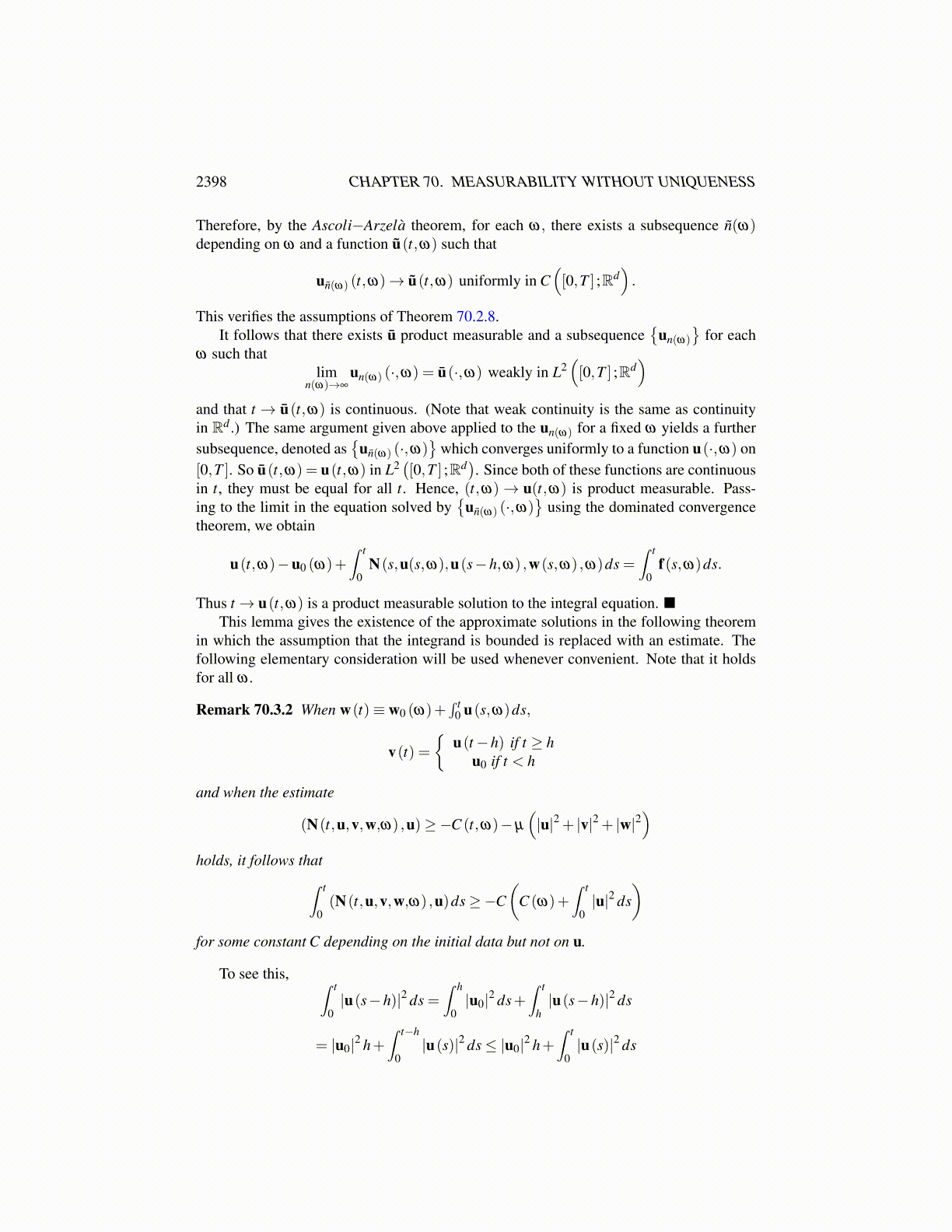
2398 CHAPTER 70. MEASURABILITY WITHOUT UNIQUENESS
Such an index exists because there exists a convergent sequence un(ω) which does convergeweakly to u. This is just picking another one which happens to also retain measurability.In fact,
{ω : k (ω) = l}={
ω : d (ul ,u)≤ 2−k}∩∩k−1
j=k
{ω : d (u j,u)> 2−k
}Since u is product measurable and each ul is also product measurable, these are all measur-able sets with respect to F and so ω → k (ω) is F measurable. Now we have uk(ω)→ uweakly in Lp′ ([0,T ] ;V ′) for each ω with each function being F measurable because
uk(ω) (t,ω) =∞
∑j=1
X[k(ω)= j]u j (t,ω)
and every term in the sum is F measurable.The following obvious corollary shows the significance of this lemma.
Corollary 70.2.7 Let V be a reflexive separable Banach space and V ′ its dual and 1p +
1p′ = 1 where p > 1 as usual. Let the functions t → un(ω) (t,ω) be in Lp′ ([0,T ] ;V ′) and(t,ω)→ un(ω) (t,ω) be B ([0,T ])×F ≡P measurable into V ′. Here
{un(ω)
}∞
n=1 is asequence, one for each ω . Suppose there is a set of measure zero N such that if ω /∈N, thenfor all n,
supt∈[0,T ]
∥∥un(ω) (t,ω)∥∥
V ′ ≤C (ω) .
Also suppose for each ω /∈ N, each subsequence of{
un(ω)
}has a further subsequence
which converges weakly in Lp′ ([0,T ] ;V ′) to u(·,ω) ∈ Lp′ ([0,T ] ;V ′) such that t→ u(t,ω)is weakly continuous into V ′. Then there exists u product measurable, with t → u(t,ω)being weakly continuous into V ′. Moreover, there exists, for each ω /∈ N, a subsequenceun(ω) such that un(ω) (·,ω)→ u(·,ω) weakly in Lp′ ([0,T ] ;V ′).
Proof: It suffices to consider the functions vn (t,ω)≡ un(ω) (t,ω) and use the result ofTheorem 70.2.1.
Of course when you have all functions having values in H a separable Hilbert space,there is no change in the argument to obtain the following theorem.
Theorem 70.2.8 Let H be a real separable Hilbert space. For n ∈ N let the functions t→un (t,ω) be in L2 ([0,T ] ;H) and (t,ω)→ un (t,ω) be B ([0,T ])×F ≡P measurable intoH. Suppose there is a set of measure zero N such that if ω /∈ N, then for all n,
supt∈[0,T ]
|un (t,ω)|H ≤C (ω) .
Also suppose for each ω /∈ N, each subsequence of {un} has a further subsequence whichconverges weakly in L2 ([0,T ] ;H) to u(·,ω)∈ L2 ([0,T ] ;H) such that t→ u(t,ω) is weaklycontinuous into H. Then there exists u product measurable, with t→ u(t,ω) being weaklycontinuous into H. Moreover, there exists, for each ω /∈ N, a subsequence un(ω) such thatun(ω) (·,ω)→ u(·,ω) weakly in L2 ([0,T ] ;H).